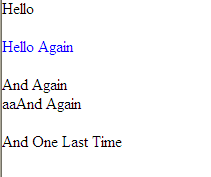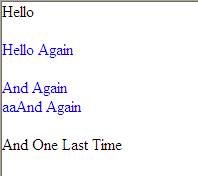 Web Front-end
Web Front-end
 JS Tutorial
JS Tutorial
 Introduction based on the difference between children() and find() in jquery_jquery
Introduction based on the difference between children() and find() in jquery_jquery
Introduction based on the difference between children() and find() in jquery_jquery
The
.children(selector) method returns all children (only children ) of each element in the set of matching elements. Parameters are optional. Adding parameters means filtering through the selector and filtering elements.
The.find(selector) method returns the descendants of each element in the matching element set. The parameter is required and can be a selector, jquery object or element to filter elements.
.find() is similar to the .children() method, except that it only traverses a single level down the DOM tree. Children here, I understand as sons, are only traversed at the son level. Look at the example: .find(selector) method returns the descendants of each element in the set of matching elements. Parameters are required and can be selectors, jquery objects or elements to filter elements. .find() is similar to the .children() method, except that it only traverses a single level down the DOM tree. Children here, I understand as sons, are only traversed at the son level. Take a look at the example:
.children The (selector) method returns all children (only children) of each element in the set of matching elements. Parameters are optional. Adding parameters means filtering through the selector and filtering elements.
The
$( 'ul.level-2').children().css('background-color', 'red');
The result of this line of code is that items A, B, C get red background. Since we didn't apply a selector expression, the jQuery object returned contains all child elements. If a selector is applied, only matching items will be included.
Looking at an example:
<script> <br> $(document).ready(function(){ <br> $("#abc").children(".selected").css("color", "blue"); <br> }); <br> </script>
Hello
p>
;aaAnd Again
🎜>
The results obtained are as follows:

This is the expected result, but if you replace the above
, see the code comments above, the result is:

Things to note about the .find() method:
1. Find is to traverse the descendants of each element in the current element collection. As long as they meet the requirements, it doesn't matter whether they are sons or grandsons.
2. Unlike other tree traversal methods, selector expressions are required parameters for .find(). If we need to retrieve all descendant elements, we can pass the wildcard selector '*'.
3. find only traverses the descendants, excluding itself.
4. The selector context is implemented by the .find() method; therefore, $('li.item-ii').find('li') is equivalent to $('li', 'li.item -ii').
The syntax of the selector is: jQuery(selector, [context])
Generally, jquery selectors are used as the first parameter. In fact, this usage of the jquery() function can also pass a second parameter. The purpose of passing this parameter is to limit the previous selector to the context environment. By default, that is, if the second parameter is not passed, the selector searches the DOM from the root of the document ($() will search for DOM elements in the current HTML document); if the second parameter is specified, such as a DOM element Set or jquery object, it will be searched in this context.
Look at an example below
$( "div.foo").click(function() {
$("span", this).addClass("bar");
});
Since we have Limit the span selector to this environment, and only the span in the clicked element will get the additional class.
Internally, the selector context is implemented through the .find() method, so $("span", this) is equivalent to $(this).find("span"),$('li.item-ii').find('li') is equivalent to $('li', 'li.item-ii')
For more information about find(), please visit: http://www.w3school.com.cn/jquery/traversing_find.asp
children() For more information, please visit: http://www.w3school.com.cn/jquery/traversing_children.asp

Hot AI Tools

Undresser.AI Undress
AI-powered app for creating realistic nude photos

AI Clothes Remover
Online AI tool for removing clothes from photos.

Undress AI Tool
Undress images for free

Clothoff.io
AI clothes remover

Video Face Swap
Swap faces in any video effortlessly with our completely free AI face swap tool!

Hot Article

Hot Tools

Notepad++7.3.1
Easy-to-use and free code editor

SublimeText3 Chinese version
Chinese version, very easy to use

Zend Studio 13.0.1
Powerful PHP integrated development environment

Dreamweaver CS6
Visual web development tools

SublimeText3 Mac version
God-level code editing software (SublimeText3)

Hot Topics
 1389
1389
 52
52
 Detailed explanation of jQuery reference methods: Quick start guide
Feb 27, 2024 pm 06:45 PM
Detailed explanation of jQuery reference methods: Quick start guide
Feb 27, 2024 pm 06:45 PM
Detailed explanation of jQuery reference method: Quick start guide jQuery is a popular JavaScript library that is widely used in website development. It simplifies JavaScript programming and provides developers with rich functions and features. This article will introduce jQuery's reference method in detail and provide specific code examples to help readers get started quickly. Introducing jQuery First, we need to introduce the jQuery library into the HTML file. It can be introduced through a CDN link or downloaded
 How to use PUT request method in jQuery?
Feb 28, 2024 pm 03:12 PM
How to use PUT request method in jQuery?
Feb 28, 2024 pm 03:12 PM
How to use PUT request method in jQuery? In jQuery, the method of sending a PUT request is similar to sending other types of requests, but you need to pay attention to some details and parameter settings. PUT requests are typically used to update resources, such as updating data in a database or updating files on the server. The following is a specific code example using the PUT request method in jQuery. First, make sure you include the jQuery library file, then you can send a PUT request via: $.ajax({u
 How to remove the height attribute of an element with jQuery?
Feb 28, 2024 am 08:39 AM
How to remove the height attribute of an element with jQuery?
Feb 28, 2024 am 08:39 AM
How to remove the height attribute of an element with jQuery? In front-end development, we often encounter the need to manipulate the height attributes of elements. Sometimes, we may need to dynamically change the height of an element, and sometimes we need to remove the height attribute of an element. This article will introduce how to use jQuery to remove the height attribute of an element and provide specific code examples. Before using jQuery to operate the height attribute, we first need to understand the height attribute in CSS. The height attribute is used to set the height of an element
 jQuery Tips: Quickly modify the text of all a tags on the page
Feb 28, 2024 pm 09:06 PM
jQuery Tips: Quickly modify the text of all a tags on the page
Feb 28, 2024 pm 09:06 PM
Title: jQuery Tips: Quickly modify the text of all a tags on the page In web development, we often need to modify and operate elements on the page. When using jQuery, sometimes you need to modify the text content of all a tags in the page at once, which can save time and energy. The following will introduce how to use jQuery to quickly modify the text of all a tags on the page, and give specific code examples. First, we need to introduce the jQuery library file and ensure that the following code is introduced into the page: <
 OPPO Find X7 is a masterpiece! Capture your every moment with images
Aug 07, 2024 pm 07:19 PM
OPPO Find X7 is a masterpiece! Capture your every moment with images
Aug 07, 2024 pm 07:19 PM
In this fast-paced era, OPPO Find X7 can use its imaging power to let us savor every beautiful moment in life. Whether it's magnificent mountains, rivers, lakes, or seas, warm family gatherings, or encounters and surprises on the street, it can help you record them with "unparalleled" picture quality. From the outside, the camera Deco design of Find It looks very recognizable and has a high-end feel. The inside is also unique, starting with the basic hardware configuration. FindX7 maintains the previous
 Use jQuery to modify the text content of all a tags
Feb 28, 2024 pm 05:42 PM
Use jQuery to modify the text content of all a tags
Feb 28, 2024 pm 05:42 PM
Title: Use jQuery to modify the text content of all a tags. jQuery is a popular JavaScript library that is widely used to handle DOM operations. In web development, we often encounter the need to modify the text content of the link tag (a tag) on the page. This article will explain how to use jQuery to achieve this goal, and provide specific code examples. First, we need to introduce the jQuery library into the page. Add the following code in the HTML file:
 OPPO Find X8 Ultra core configuration exposed! Snapdragon 8 Gen4+ Extra Large Battery
Aug 22, 2024 pm 06:54 PM
OPPO Find X8 Ultra core configuration exposed! Snapdragon 8 Gen4+ Extra Large Battery
Aug 22, 2024 pm 06:54 PM
On August 22, a digital blogger revealed some core configuration information of OPPO Find X8 Ultra. According to the exposed content, this high-end model will be equipped with Qualcomm’s latest Snapdragon 8Gen4 mobile platform, equipped with a 6000mAh ultra-large capacity battery, and supports 100W wired fast charging and 50W wireless fast charging functions. Appearance design There is currently no specific design information about OPPO Find X8 Ultra. But the real picture of the standard version of OPPO Find X8 has been exposed on the Internet. Appearance of FindX8 Judging from the exposed photos, the rear camera module of OPPO FindX8 adopts a square design with a certain degree of curvature at the four corners, giving a more rounded feeling. In addition, the machine adopts a direct
 Understand the role and application scenarios of eq in jQuery
Feb 28, 2024 pm 01:15 PM
Understand the role and application scenarios of eq in jQuery
Feb 28, 2024 pm 01:15 PM
jQuery is a popular JavaScript library that is widely used to handle DOM manipulation and event handling in web pages. In jQuery, the eq() method is used to select elements at a specified index position. The specific usage and application scenarios are as follows. In jQuery, the eq() method selects the element at a specified index position. Index positions start counting from 0, i.e. the index of the first element is 0, the index of the second element is 1, and so on. The syntax of the eq() method is as follows: $("s



